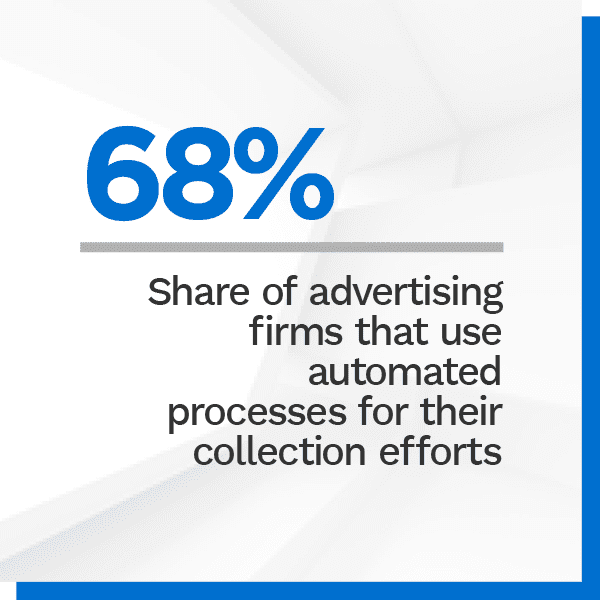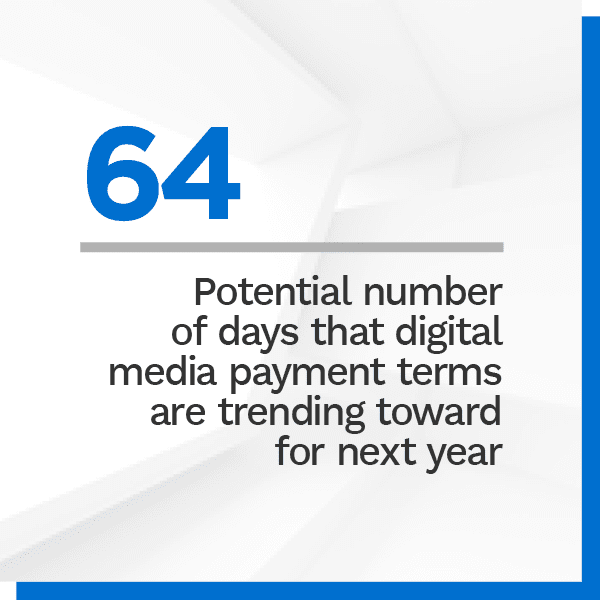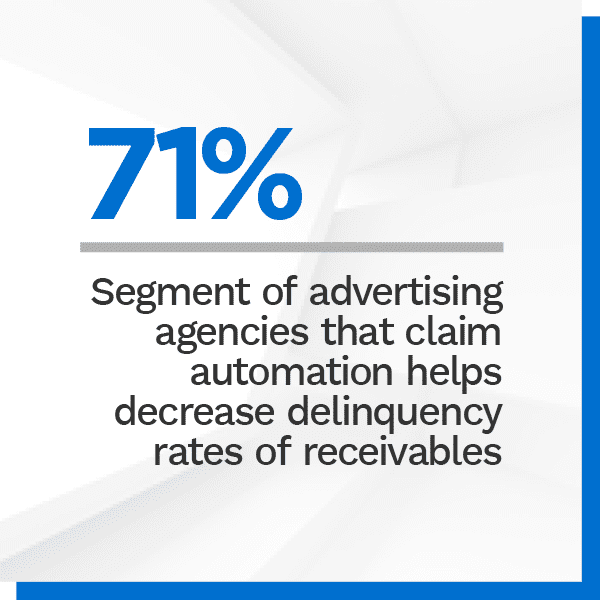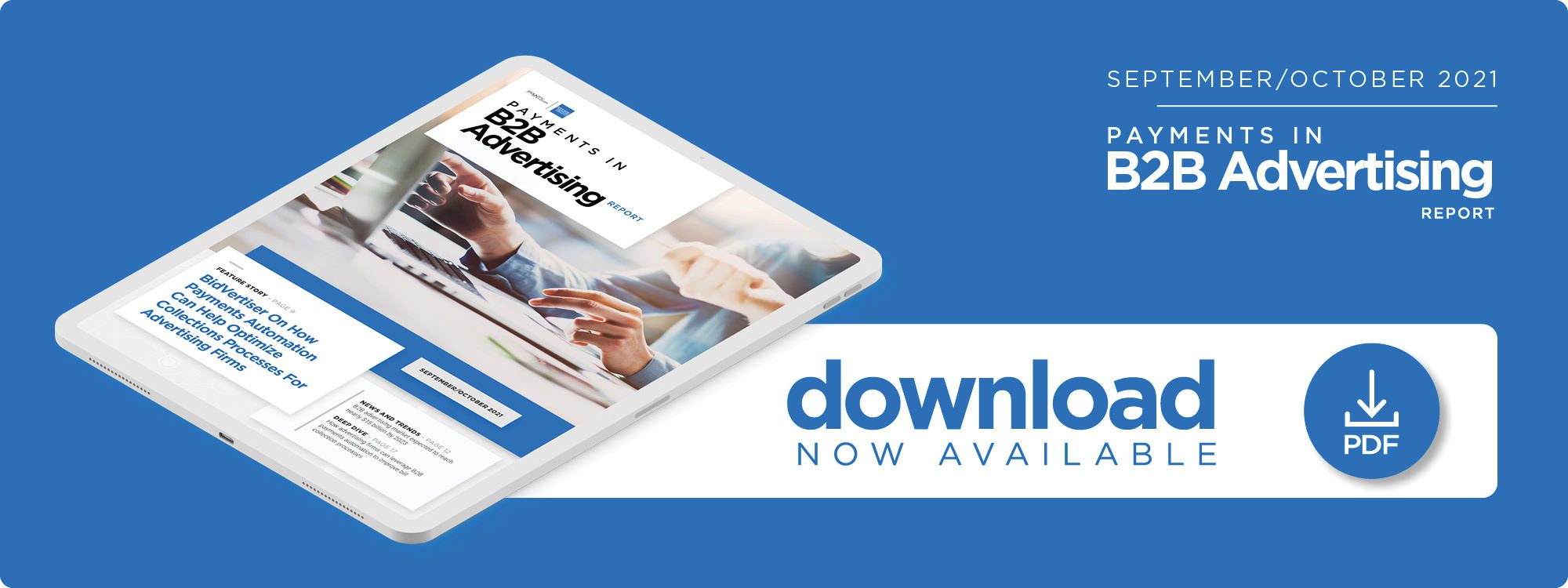Report: Payment Choice, Automation Key to Global B2B Advertising Growth

No business was immune to the digital push brought on by the pandemic, and B2B companies took note.
With a greater demand for alternative payment options, businesses around the globe looked to their service providers to take action. Among the early adopters were digital advertising firms, and PYMNTS research shows that more than 68% of these businesses are now using automated technology to prioritize collections of fees.
Most companies noticed the benefits of digital payments and innovated accordingly, and 71% reported improved collections following accounts receivable (AR) automation. Yet while B2B automation capabilities are superior to legacy systems, several friction points still exist within the technology. Advertising firms take a mere 11 days to follow up on collections, for example, but the average days sales outstanding (DSO) rate for all other businesses is a whopping 42.5 days. B2B organizations can incorporate tools such as virtual cards to combat this issue and further streamline the process.
days to follow up on collections, for example, but the average days sales outstanding (DSO) rate for all other businesses is a whopping 42.5 days. B2B organizations can incorporate tools such as virtual cards to combat this issue and further streamline the process.
In the Payments In B2B Advertising Report, PYMNTS examines how B2B advertising firms can update their legacy payments systems and use electronic payments to increase revenue, reduce friction and improve the customer experience.
Around the Payments in B2B Advertising Space
A shift in how B2B companies advertise their products and services occurred in the past 19 months. Now, display advertising is predicted to reach roughly $5.1 billion for United States B2B organizations in 2021, a 33% increase from $3.8 billion in 2020. Reports show that technology products and service providers were in the highest spending bracket for U.S. B2B digital advertisements this year, totaling 32% of all sales. Financial services were the runners-up in spending, accounting for 25% of B2B display ad and search spending.
 B2B cross-border transactions are expected to surpass $42.7 trillion in value by 2026, an approximate $8 trillion increase from 2021. Wire transfers account for 70% of transactions in the space and are predicted to reach 80% by 2026. B2B cross-border payments providers are setting their sights on payment automation processes, as legacy payments options are often slow and hard to track to completion. Research suggests payments vendors should provide companies with a range of user-friendly methods, such as virtual cards, to make up for current weaknesses in cross-border instant payments.
B2B cross-border transactions are expected to surpass $42.7 trillion in value by 2026, an approximate $8 trillion increase from 2021. Wire transfers account for 70% of transactions in the space and are predicted to reach 80% by 2026. B2B cross-border payments providers are setting their sights on payment automation processes, as legacy payments options are often slow and hard to track to completion. Research suggests payments vendors should provide companies with a range of user-friendly methods, such as virtual cards, to make up for current weaknesses in cross-border instant payments.
Travel restrictions and border closures interrupted the workflow of many businesses. Despite this, B2B cross-border payments are expected to continue their upward trajectory, with one report predicting a 14% increase in these transactions from 2020 to 2021. A significant segment of B2B businesses intend to prioritize investments in eCommerce migration by 2023, and more than 80% of B2B worldwide leaders reported that beginning omnichannel investments by 2023 was essential. The B2B market usually lags behind other sectors of the payments space regarding digital transformation, but accelerated adoption of technology during the pandemic has motivated many market executives to reevaluate their approaches.
For more on these and other stories, visit the Report’s News & Trends.
Digital Advertising Platform BidVertiser on Expanding Market Reach With Automated Payments
Before the pandemic, companies could get by with legacy payments processes, such as cash, paper checks and even debit or credit cards. Since then, the accelerated adoption of electronic payments has created a demand for alternative payment options that customers have come to expect from their goods and services providers. B2B companies are no exception, and digital advertising firms were among those most willing to adopt new payments technology.
Different corners of the market have their own personal payment preferences, said Shahar Jacobi, CEO of the self-service advertising platform BidVertiser.
To learn more about why digital advertising firms and other B2B companies should combine digitize their accounts payable (AP)/AR processes, visit the Report’s Feature Story.
Deep Dive: Advertising Companies Have Much to Gain From Digitizing B2B Payments
The B2B space is feeling the influence of the pandemic-driven shift to digital payments, and many organizations now recognize the list of benefits digital B2B payments technology has to offer. Some of the key advantages of digitizing legacy systems are cost savings when distributing funds and better prediction of times to settlement. Approximately one-third of U.S. businesses still use outdated systems and cash or paper checks to conduct transactions, however, which can create friction and delay payment processes.
To learn more about how automated AR processes can lower delinquency rates and DSO, visit the Report’s Deep Dive.
About the Report
The Payments In B2B Advertising Report, done in collaboration with American Express, offers coverage of the most recent news and trends regarding advancements in digital payments strategies for B2B advertisement firms and other B2B companies.

